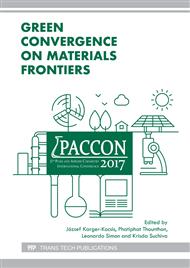[1]
Paul Wambua, Jan Ivens, Ignaas Verpoest, Natural fibers: can they replace glass in fibre reinforced plastics?, Composites Science and Technology. 63 (2003) 1259-1264.
DOI: 10.1016/s0266-3538(03)00096-4
Google Scholar
[2]
H. Ku, H. Wang, N. Pattarachaiyakoop, M. Trada, A review on tensile properties of natural fiber reinforced polymer composites, Composites: Part B 42 (2011) 856-873.
DOI: 10.1016/j.compositesb.2011.01.010
Google Scholar
[3]
M. John, S. Thomas, Biofibres and biocomposites, Carbohydr Polym 71: 3 (2008) 345-364.
Google Scholar
[4]
G. Goud and R. N. Rao, Effect of fibre content and alkali treatment on mechanical properties of Roystonea regia-reinforced epoxy partially biodegradable composites, Bull. Mater. Sci. 34: 7 (2011) 1575-1581.
DOI: 10.1007/s12034-011-0361-4
Google Scholar
[5]
C. Uma Maheswari, K. Obi Reddy, E. Muzenda, M. Shukla, Effect of surface treatment on performance of tamarind fiber-epoxy composites, Proceeding of international conference on innovations in chemical engineering and medical science. (2012) 16-19.
Google Scholar
[6]
B.E. Yousif, A. Shalwan, C.W. Chin, K.C. Ming, Flexural properties of treated and untreated kenaf0epoxy composites, Materials and Design. 40 (2012) 378-385.
DOI: 10.1016/j.matdes.2012.04.017
Google Scholar
[7]
V. Vilay, M. Mariatti, R. Mat Taib, M. Todo, Effect of fiber surface treatment and fiber loading on the properties of bagasse fiber-reinforced unsaturated polyester composites, Compos Sci and Technol. 69: 3-4 (2008) 631-638.
DOI: 10.1016/j.compscitech.2007.10.005
Google Scholar
[8]
M. Rokbi, H. Osmani, A. Imad, N. Benseddiq, Effect of chemical treatment of flexural properties of natural fiber-reinforced polyester composite. Procedia Eng. 10 (2011) 2092-97.
DOI: 10.1016/j.proeng.2011.04.346
Google Scholar
[9]
Y. Cao, S. Shibata, I. Fukumoto, Mechanical properties of biodegradable composites reinforced with bagasse fibre before and after alkali treatments, Composites: Part A. 37 (2006) 423-429.
DOI: 10.1016/j.compositesa.2005.05.045
Google Scholar
[10]
A. Vazquez, V.A. Dominquez, Bagasse fiber-polypropylene based composites, J. Thermoplast Compos Mater. (1999) 12-17.
Google Scholar
[11]
Beckermann G.W., Pickering K.L., Engineering and evaluation of hemp fibre reinforced polypropylene composites: fibre treatment and matrix modification, Composites Part A. (2008) 39(6) 979-88.
DOI: 10.1016/j.compositesa.2008.03.010
Google Scholar
[12]
A.N. Fraga, E. Frulloni,O. De la Osa, J.M. Kenny, A. Vazquez, Relationship between water absorption and dielectric behavior of natural fiber composite materials, Polymer Test. 25 (2006) 181-187.
DOI: 10.1016/j.polymertesting.2005.11.002
Google Scholar
[13]
X. Wang, Y. Hu, L. Song, W. Xing, H. Lu, Thermal degradation mechanism of flame retarded epoxy resin with a DOPO-substitued organophosphorus oligomer by TG-FTIR and DP-MS. J Anal Appl Pyrolysis. 92: 1 (2011) 164-170.
DOI: 10.1016/j.jaap.2011.05.006
Google Scholar
[14]
Z.N. Azwa, B.F. Yousif, Characteristics of kenaf fibre/epoxy composites subjected to thermal degradation, Polymer degradation and stability. 98 (2013) 2752-2759.
DOI: 10.1016/j.polymdegradstab.2013.10.008
Google Scholar


